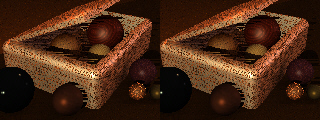Release Notes
Status Feb. 2003
StereoPOV 0.2 is an experimental feature or addition to the »official« POV-Ray 3.5.
StereoPOV 0.2 is beta software. There are known bugs (and probably unknown bugs
as well). The patch proved to work correctly for the author, but it still needs more testing.
Until now, it was built and tested only on the Windows Platform. It is
work in progress, all features may change in future Versions.
Status Update March 2005: known Bugs
- There are Problems building at Linux due to some code carried over form
erlier versions. It is possible to build with some quirks, see the notes
on the download page.
- Patching of the sources can be difficult.
- The X-window preview (linux/unix) doesn't display both halfimages
correctly. The generated image files of course are correct.
- A bug (and a fix) concerning alpha channel support was reported.
- Shortly I discovered a rather obscure bug when the filter and transmit
values of a texture sum up to something >1
- StereoPOV is still based on POV-Ray 3.5

strange behaviour
The following issues are rather unavoidable but nasty behaviour.
At the moment, I consider them »WONTFIX« (but maybe,
someone has a clever idea how to cope with...)
- At surfaces running in depth direction, StereoCache produces artificial steps or breaks
at regular distances. This behaviour is an immediate consequence of StereoCaches function
principle (it uses discrete "slots" for every possible pixel/subpixel). This is sort of
an aliasing problem in depth direction.

The edge of the box
seems to float in the air
(cross-eye)
- Antialiasing doesn't work so smooth on the half image, where cached intersections are
reused. I.e. you get more noticable steps or slightly irregular borders on one side.
The cause is the same as mentioned before. And this phenomenon diminuishes with growing
resolution as well. We need high res to get sensible results for stereoscopy anyway,
so this is not considered a problem.
- Every AA glitch or rounding error produced by the raytracing functions is very visible.
This is a general problem of stereoscopy (dust on slides, scratches, image errors
"leap into view").
The only answer is: try to solve the problem (i.e. wrong texture property values), increase
the resolution and – if nothing else helps – post-process the image. You really
need to correct such problems, as everybody will be staring fascinated at the image errors
all the time, completely ignoring the content
of your image.

- Continuing a trace whilst switching Stereo-mode on/off produces rubbish (of course).
- Using large amounts of AA-jitter can drastically reduce the StereoCache hit rates. If
you use area lights in your scene and thusly depend on StereoCache to hide the jitter
introduced by the area lights, you will notice this problem, as the area light jitter
now will show up as image error at places.
- As reflected and refracted rays can't use StereoCache, the area light jitter will show
up as grainyness in mirrors, glass or transparent objects, water etc, whilst beeing
invisible (or apear as mapped to the surface) for primary rays thanks to StereoCache.
- Focal blur works but defeats StereoCache (the hit rates go down to near zero). It seems
to influence the Stereo Window placement to some extent as well. I don't consider this
a problem, because the same way as in real world photography, focal blur is very important
for common (flat, mono) imaging and almost complete of no importance for stereoscopy,
because in stereoscopy normally there is no problem distinguishing the main object of interest
from the background. The difference between "main object" and "background" is present
in stereoscopy rather as a problem of image composition or concept, than as a problem
of "being able to distinguish, what is »on« the picture"
- The statistic nature of the media tracing process shows up much more in STEREO-trace
mode. First experiments indicate, that much more quality/computation power is needed
to gain good results. Needs more investigation.
Please feel free to contact me if you encounter
further bugs or problems.



